[English] 日本語
 Yorodumi
Yorodumi- PDB-1fqv: Insights into scf ubiquitin ligases from the structure of the skp... -
+ Open data
Open data
- Basic information
Basic information
| Entry | Database: PDB / ID: 1fqv | ||||||
|---|---|---|---|---|---|---|---|
| Title | Insights into scf ubiquitin ligases from the structure of the skp1-skp2 complex | ||||||
 Components Components |
| ||||||
 Keywords Keywords | LIGASE / Skp1 / Skp2 / F-box / LRR / leucine-rich repeat / SCF / ubiquitin / E3 / ubiquitin protein ligase | ||||||
| Function / homology |  Function and homology information Function and homology informationpositive regulation of protein polyubiquitination / F-box domain binding / cellular response to cell-matrix adhesion / Aberrant regulation of mitotic exit in cancer due to RB1 defects / PcG protein complex / positive regulation of ubiquitin protein ligase activity / Cul7-RING ubiquitin ligase complex / maintenance of protein location in nucleus / Loss of Function of FBXW7 in Cancer and NOTCH1 Signaling / SCF ubiquitin ligase complex ...positive regulation of protein polyubiquitination / F-box domain binding / cellular response to cell-matrix adhesion / Aberrant regulation of mitotic exit in cancer due to RB1 defects / PcG protein complex / positive regulation of ubiquitin protein ligase activity / Cul7-RING ubiquitin ligase complex / maintenance of protein location in nucleus / Loss of Function of FBXW7 in Cancer and NOTCH1 Signaling / SCF ubiquitin ligase complex / SCF-dependent proteasomal ubiquitin-dependent protein catabolic process / positive regulation of intracellular estrogen receptor signaling pathway / Prolactin receptor signaling / ubiquitin ligase complex scaffold activity / cullin family protein binding / protein K63-linked ubiquitination / protein monoubiquitination / ubiquitin-like ligase-substrate adaptor activity / protein K48-linked ubiquitination / positive regulation of double-strand break repair via homologous recombination / Nuclear events stimulated by ALK signaling in cancer / positive regulation of smooth muscle cell proliferation / molecular function activator activity / Regulation of BACH1 activity / MAP3K8 (TPL2)-dependent MAPK1/3 activation / SCF-beta-TrCP mediated degradation of Emi1 / NIK-->noncanonical NF-kB signaling / Vpu mediated degradation of CD4 / Dectin-1 mediated noncanonical NF-kB signaling / Activation of NF-kappaB in B cells / Degradation of GLI1 by the proteasome / Iron uptake and transport / GSK3B and BTRC:CUL1-mediated-degradation of NFE2L2 / Negative regulation of NOTCH4 signaling / G1/S transition of mitotic cell cycle / APC/C:Cdh1 mediated degradation of Cdc20 and other APC/C:Cdh1 targeted proteins in late mitosis/early G1 / FBXL7 down-regulates AURKA during mitotic entry and in early mitosis / Degradation of GLI2 by the proteasome / GLI3 is processed to GLI3R by the proteasome / beta-catenin binding / Degradation of beta-catenin by the destruction complex / NOTCH1 Intracellular Domain Regulates Transcription / CLEC7A (Dectin-1) signaling / SCF(Skp2)-mediated degradation of p27/p21 / Constitutive Signaling by NOTCH1 PEST Domain Mutants / Constitutive Signaling by NOTCH1 HD+PEST Domain Mutants / G2/M transition of mitotic cell cycle / FCERI mediated NF-kB activation / Interleukin-1 signaling / protein polyubiquitination / Orc1 removal from chromatin / Regulation of RUNX2 expression and activity / Cyclin D associated events in G1 / : / Regulation of PLK1 Activity at G2/M Transition / Downstream TCR signaling / Antigen processing: Ubiquitination & Proteasome degradation / Neddylation / regulation of apoptotic process / defense response to virus / proteasome-mediated ubiquitin-dependent protein catabolic process / regulation of cell cycle / Ub-specific processing proteases / protein ubiquitination / chromatin remodeling / protein domain specific binding / innate immune response / centrosome / nucleolus / nucleoplasm / identical protein binding / nucleus / cytosol / cytoplasm Similarity search - Function | ||||||
| Biological species |  Homo sapiens (human) Homo sapiens (human) | ||||||
| Method |  X-RAY DIFFRACTION / X-RAY DIFFRACTION /  SYNCHROTRON / Resolution: 2.8 Å SYNCHROTRON / Resolution: 2.8 Å | ||||||
 Authors Authors | Schulman, B.A. / Carrano, A.C. / Jeffrey, P.D. / Bowen, Z. / Kinnucan, E.R. / Finnin, M.S. / Elledge, S.J. / Harper, J.W. / Pagano, M. / Pavletich, N.P. | ||||||
 Citation Citation |  Journal: Nature / Year: 2000 Journal: Nature / Year: 2000Title: Insights into SCF ubiquitin ligases from the structure of the Skp1-Skp2 complex. Authors: Schulman, B.A. / Carrano, A.C. / Jeffrey, P.D. / Bowen, Z. / Kinnucan, E.R. / Finnin, M.S. / Elledge, S.J. / Harper, J.W. / Pagano, M. / Pavletich, N.P. | ||||||
| History |
|
- Structure visualization
Structure visualization
| Structure viewer | Molecule:  Molmil Molmil Jmol/JSmol Jmol/JSmol |
|---|
- Downloads & links
Downloads & links
- Download
Download
| PDBx/mmCIF format |  1fqv.cif.gz 1fqv.cif.gz | 697.4 KB | Display |  PDBx/mmCIF format PDBx/mmCIF format |
|---|---|---|---|---|
| PDB format |  pdb1fqv.ent.gz pdb1fqv.ent.gz | 584.3 KB | Display |  PDB format PDB format |
| PDBx/mmJSON format |  1fqv.json.gz 1fqv.json.gz | Tree view |  PDBx/mmJSON format PDBx/mmJSON format | |
| Others |  Other downloads Other downloads |
-Validation report
| Summary document |  1fqv_validation.pdf.gz 1fqv_validation.pdf.gz | 501 KB | Display |  wwPDB validaton report wwPDB validaton report |
|---|---|---|---|---|
| Full document |  1fqv_full_validation.pdf.gz 1fqv_full_validation.pdf.gz | 697.2 KB | Display | |
| Data in XML |  1fqv_validation.xml.gz 1fqv_validation.xml.gz | 97.3 KB | Display | |
| Data in CIF |  1fqv_validation.cif.gz 1fqv_validation.cif.gz | 141.3 KB | Display | |
| Arichive directory |  https://data.pdbj.org/pub/pdb/validation_reports/fq/1fqv https://data.pdbj.org/pub/pdb/validation_reports/fq/1fqv ftp://data.pdbj.org/pub/pdb/validation_reports/fq/1fqv ftp://data.pdbj.org/pub/pdb/validation_reports/fq/1fqv | HTTPS FTP |
-Related structure data
- Links
Links
- Assembly
Assembly
| Deposited unit | 
| ||||||||
|---|---|---|---|---|---|---|---|---|---|
| 1 | 
| ||||||||
| 2 | 
| ||||||||
| 3 | 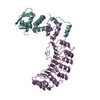
| ||||||||
| 4 | 
| ||||||||
| 5 | 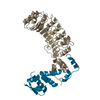
| ||||||||
| 6 | 
| ||||||||
| 7 | 
| ||||||||
| 8 | 
| ||||||||
| Unit cell |
|
- Components
Components
| #1: Protein | Mass: 37923.691 Da / Num. of mol.: 8 / Fragment: 101-436 Source method: isolated from a genetically manipulated source Source: (gene. exp.)  Homo sapiens (human) / Production host: Homo sapiens (human) / Production host:  #2: Protein | Mass: 16853.164 Da / Num. of mol.: 8 Source method: isolated from a genetically manipulated source Source: (gene. exp.)  Homo sapiens (human) / Production host: Homo sapiens (human) / Production host:  |
|---|
-Experimental details
-Experiment
| Experiment | Method:  X-RAY DIFFRACTION / Number of used crystals: 1 X-RAY DIFFRACTION / Number of used crystals: 1 |
|---|
- Sample preparation
Sample preparation
| Crystal | Density Matthews: 2.56 Å3/Da / Density % sol: 52.01 % | |||||||||||||||||||||||||
|---|---|---|---|---|---|---|---|---|---|---|---|---|---|---|---|---|---|---|---|---|---|---|---|---|---|---|
| Crystal grow | Temperature: 277 K / Method: vapor diffusion, hanging drop / pH: 8.5 Details: PEG 4000, Tris-Cl, ammonium acetate, DTT, pH 8.5, VAPOR DIFFUSION, HANGING DROP, temperature 277K | |||||||||||||||||||||||||
| Crystal grow | *PLUS Temperature: 4 ℃ / Details: microseeding and macroseeding | |||||||||||||||||||||||||
| Components of the solutions | *PLUS
|
-Data collection
| Diffraction source | Source:  SYNCHROTRON / Site: SYNCHROTRON / Site:  CHESS CHESS  / Beamline: A1 / Wavelength: 0.909 / Beamline: A1 / Wavelength: 0.909 |
|---|---|
| Radiation | Protocol: SINGLE WAVELENGTH / Monochromatic (M) / Laue (L): M / Scattering type: x-ray |
| Radiation wavelength | Wavelength: 0.909 Å / Relative weight: 1 |
| Reflection | Resolution: 2.8→8 Å / Num. obs: 90445 |
| Reflection | *PLUS Highest resolution: 2.8 Å / Num. obs: 108372 / % possible obs: 93.7 % / Num. measured all: 598299 / Rmerge(I) obs: 0.074 |
| Reflection shell | *PLUS % possible obs: 93.8 % / Rmerge(I) obs: 0.194 / Mean I/σ(I) obs: 5.1 |
- Processing
Processing
| Software |
| |||||||||||||||
|---|---|---|---|---|---|---|---|---|---|---|---|---|---|---|---|---|
| Refinement | Resolution: 2.8→8 Å / σ(F): 2
| |||||||||||||||
| Refinement step | Cycle: LAST / Resolution: 2.8→8 Å
| |||||||||||||||
| Software | *PLUS Name: CNS / Classification: refinement | |||||||||||||||
| Refine LS restraints | *PLUS
| |||||||||||||||
| LS refinement shell | *PLUS Rfactor Rfree: 0.429 / Rfactor Rwork: 0.353 |
 Movie
Movie Controller
Controller


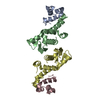
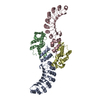



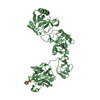

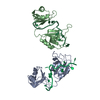
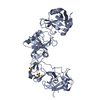

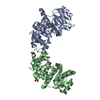
 PDBj
PDBj











